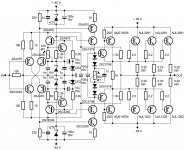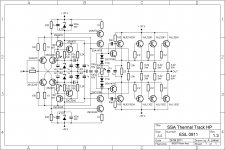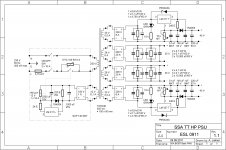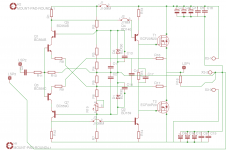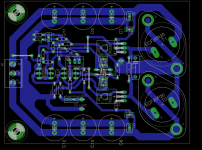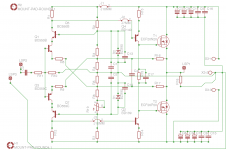1k trimmer instead of D1+D2 will do the bias job properly for your schematic?
Yes it would. I use diodes because I once had a pot that went open which sets the bias to whatever current the transformer was capable of. Was not a nice sight.
shaan..
I agree the VBE-mult does stabilize the bias-spread..but at the cost of reducing the bias current twice with temperature..to me this makes an emphasis on the typical soft character of the Lateral mosfets..
An alternative could be to keep the VBE away from the heat-sink.. then you reduce negative temp-co to that of the mosfet itself...
I agree the VBE-mult does stabilize the bias-spread..but at the cost of reducing the bias current twice with temperature..to me this makes an emphasis on the typical soft character of the Lateral mosfets..
An alternative could be to keep the VBE away from the heat-sink.. then you reduce negative temp-co to that of the mosfet itself...
What about an IR led instead of D1+D2?🙂
The higher the volt drop the higher the bais current. A RED led is about 1.5V and would set the bias around 240 mA same as two diodes. Thus you would dissipate around 8 watt per output device.
I cannot remember the exact reference but some engineer at Texas Instruments wrote a paper on an amp design and found that the optimum bias setting for Hitachi 2SK1059/2SJ162 is around 180 mA for the lowest distortion. I posted the article toward the end of one of the two Goldmund threads of late.
shaan..
I agree the VBE-mult does stabilize the bias-spread..but at the cost of reducing the bias current twice with temperature..to me this makes an emphasis on the typical soft character of the Lateral mosfets..
An alternative could be to keep the VBE away from the heat-sink.. then you reduce negative temp-co to that of the mosfet itself...
I think lateral FETs have positive tempco. Yes with the laterals the vbe multiplier has nothing to do on the heatsink and can rest on-board. It should be placed on the heatsink IF we are using vertical devices.
An infrared is 1.11V at 4.25mA across my stash. Many REDs are rather happier than 1.5V these days. Maybe using a BF245A in CCS mode to feed the LED can be of some benefit?
Funny, on my amp, tuned for best listening with my ears, i had finished with around 150mA per unit (300mA total by channel for 2 // mosfets). Is is perfect as it gives a Class A for the normal listening level with all the power margin you need for pics.I cannot remember the exact reference but some engineer at Texas Instruments wrote a paper on an amp design and found that the optimum bias setting for Hitachi 2SK1059/2SJ162 is around 180 mA for the lowest distortion.
Here is the paper again, I cannot find the actual thread.
100-200mA from a quick look up for the Renesas pair used here. Hmm, the 1.11V Infrared looks like a candidate.
If someone would like to make high performance SSA, here is my proposal. Of course I could make it even more complex but I think this one would have enough zeroes for minimal THD lovers. 😉
Hello Lazy cat ,
Could you please verify if this schematic posted here in post 347 is valid
Attachments
SSA Thermal Track High Performance + Power Supply Unit
A little more complex but surely very realistic version for you. 😉
Hello Lazy cat ,
Could you please verify if this schematic posted here in post 347 is valid
A little more complex but surely very realistic version for you. 😉
Attachments
Thanks LC, so the amp schematic is the same , the PSU ? 😕 anyway it would be too small for my application of 1000va/ch .
Could a slave a few more outputs ( 4 ) to that design..?
Could a slave a few more outputs ( 4 ) to that design..?
just wanted someone to check through my work and to share it with you all.
i know there are no values on the res and caps but i can play with that later as ill take them from the many posts and play with the averages.
thanks for looking, any comments thanks in advance, steve.
i know there are no values on the res and caps but i can play with that later as ill take them from the many posts and play with the averages.
thanks for looking, any comments thanks in advance, steve.
Attachments
Hi a.wayne 😉
SSA schematic is different, as some compensating caps were added.
You need 1000W on which impedance? In accordance to current level and SOA, the number of output BJTs and supply voltage can be calculated. Output stage current gain is enormous so there should be no problem driving it with proposed front-end. 🙂
SSA schematic is different, as some compensating caps were added.
You need 1000W on which impedance? In accordance to current level and SOA, the number of output BJTs and supply voltage can be calculated. Output stage current gain is enormous so there should be no problem driving it with proposed front-end. 🙂
Hi a.wayne 😉
SSA schematic is different, as some compensating caps were added.
You need 1000W on which impedance? In accordance to current level and SOA, the number of output BJTs and supply voltage can be calculated. Output stage current gain is enormous so there should be no problem driving it with proposed front-end. 🙂
Hello LC... goal is 600-800 watts/ch into 1 ohm or 20 amps capability per channel.can i substitute the NJL outputs for MJL , is there a difference ...?
Last edited:
just wanted someone to check through my work and to share it with you all.
Hi psychosteve72 😉
Please make some little corrections to your sch - some junctions are missing. Recheck the sch and than we can say things related to PCB.
Otherwise nice work, TO3-s looks great on PCB, congratullations. 🙂
Hello LC... goal is 600-800 watts/ch into 1 ohm or 20 amps capability per channel.
a.wayne no problem 😉
For the power 800Wrms/1ohm, peak output voltage will be 40Vp, and peak output current 40Ap. Output transistors behave normally up to Ic=6-7Ap so you would need six pairs of the outputs, +/-50V supply voltage for the output stage and +/-60V for the SSA front-end. Some components values have to be recalculated and I can prepare this especially for your specific case till tomorrow. 🙂
- Status
- Not open for further replies.
- Home
- Amplifiers
- Solid State
- Simple Symetrical Amplifier

